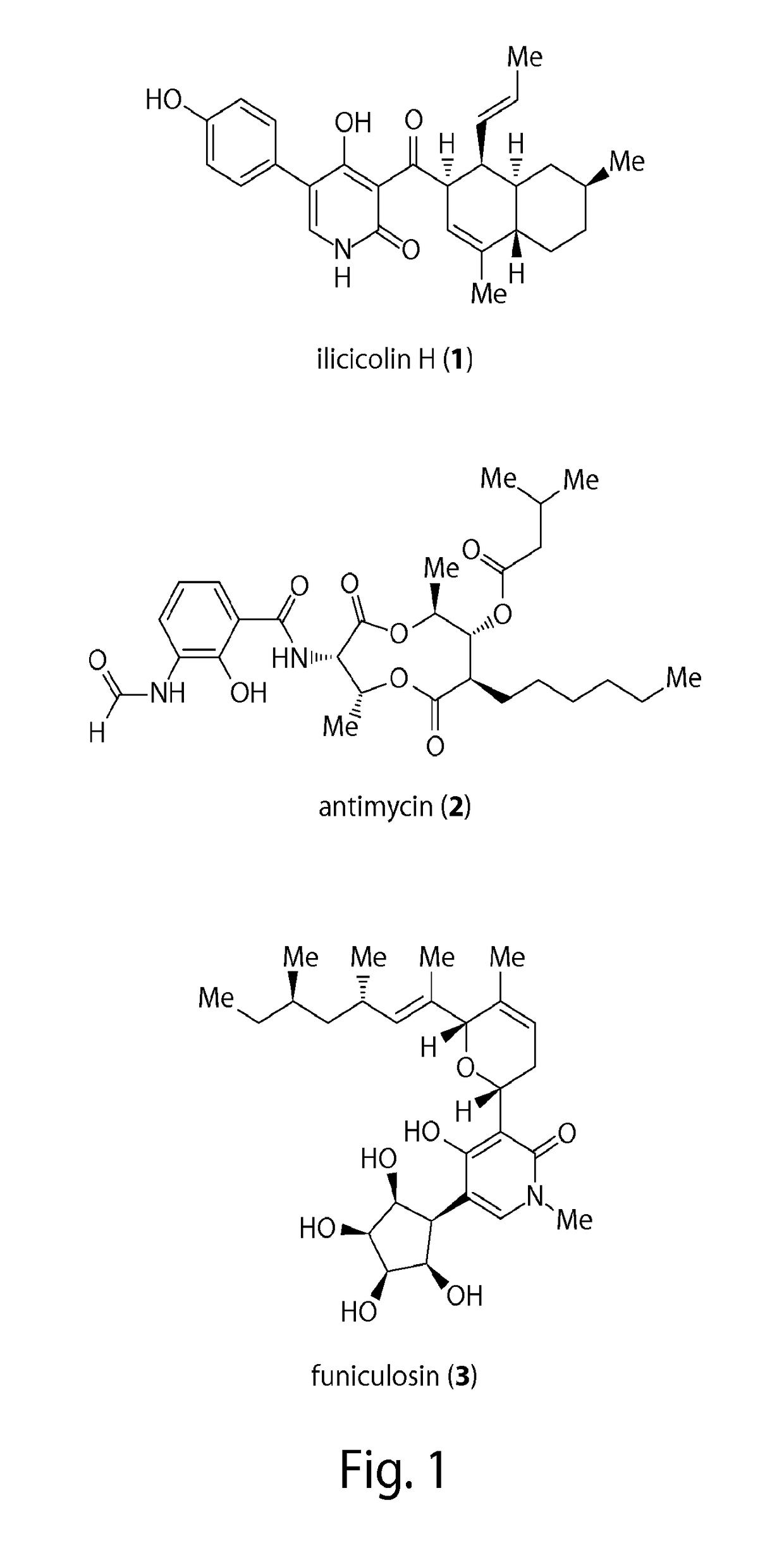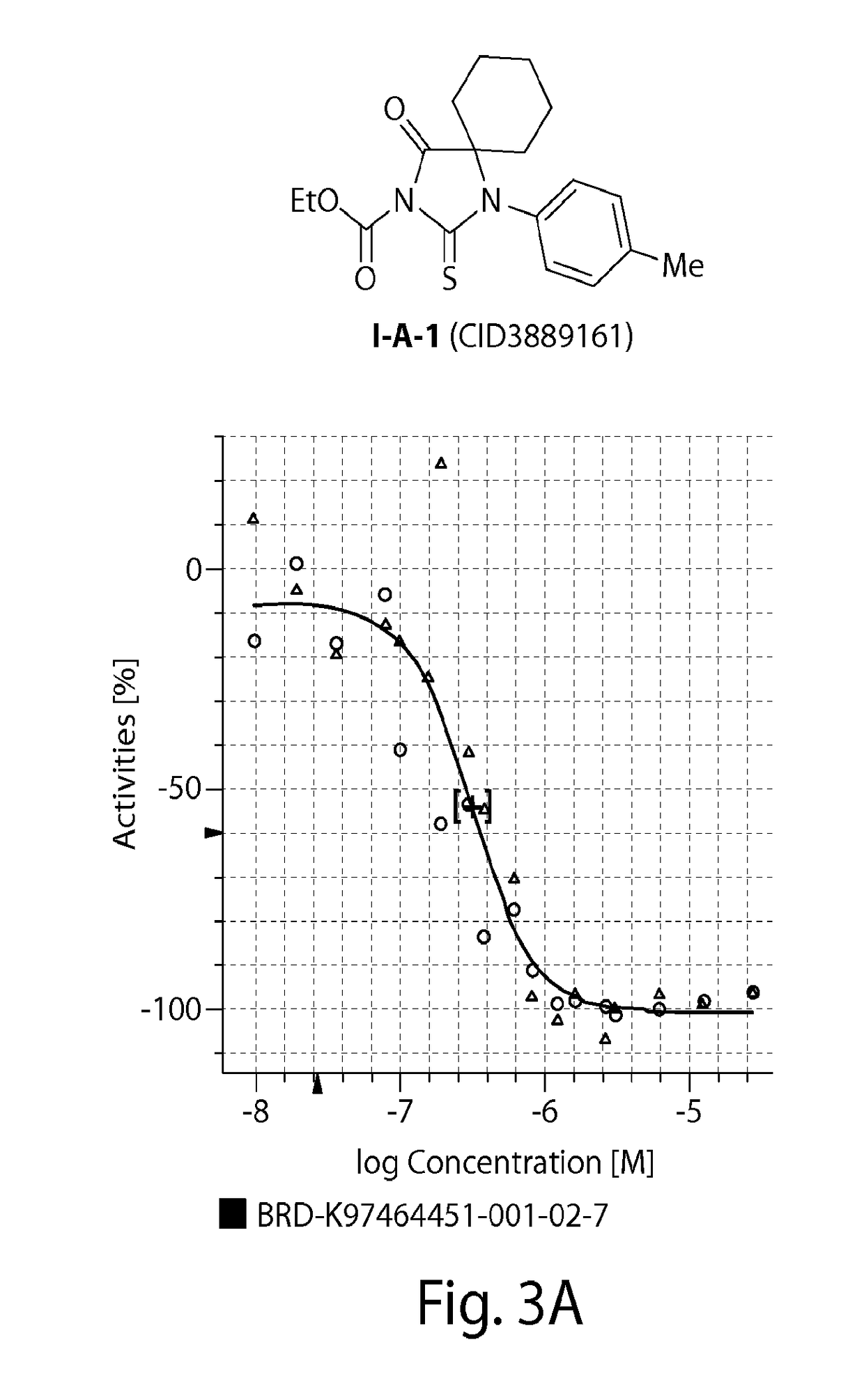Thiohydantoin derivatives and uses thereof
a technology of thiohydantoin and derivatives, which is applied in the field of thiohydantoin derivatives, can solve the problems that the role of glycolytic versus respiratory metabolism in supporting fungal virulence and drug resistance has not been fully investigated, and achieves the effects of reducing or avoiding symptoms or causes of the condition, reducing or minimizing one or more symptoms, and reducing or minimizing the overall therapy
- Summary
- Abstract
- Description
- Claims
- Application Information
AI Technical Summary
Benefits of technology
Problems solved by technology
Method used
Image
Examples
example 1
Compounds Screening Strategy
[0352]The various metabolic pathways of medically relevant fungi have recently come under investigation for their roles in fungal pathogenicity and the acquisition of drug resistance (Shingu-Vazquez et al., Eukaryot. Cell 2011, 10(11):1376-83; Martins et al., J. Bioenerg. Biomembr. 2011, 43(1):81-8). Specifically, the mitochondrion and its numerous components and functions are emerging as factors in determining the effectiveness of current antimycotic therapies in controlling human fungal infections. In vitro experiments have shown that loss of mitochondrial DNA (mtDNA) in C. glabrata correlates to increased resistance to azole antifungals (Brun et al., J. Antimicrob. Chemother. 2005, 56:307-314). Paradoxically, clinical isolates of azole-resistant C. glabrata rarely show impairment of mtDNA function. The significance of the seemingly contradictory in vitro assays remains to be seen (Bouchara et al., J. Med. Microbiol. 2000, 49(11):977-84; Ferrari et al.,...
example 2
Preparation of the Compounds
[0358]Compounds of Formula (I) (e.g., probe compound I-B-4 (ML316)) may be prepared by the synthetic sequence outlined below in Scheme 1. Cyclohexanone was subjected to a Strecker reaction with 4-fluoroaniline and trimethylsilyl cyanide. The resulting adduct 4 was cyclized to the hydantoin 5 with sodium cyanate, converted to the thiohydanatoin 6, and acylated with ethyl chloroformate to provide compound I-B-4.
[0359]
2.1. General Methods
[0360]All reagents and solvents were purchased from commercial vendors and used as received. NMR spectra were recorded on a Bruker 300 MHz or Varian UNITY INOVA 500 MHz spectrometer as indicated. Proton, fluorine, and carbon chemical shifts are reported in parts per million (ppm; δ) relative to tetramethylsilane, CFCl3, or CDCl3 solvent (1H δ 0, 19F δ 0, 13C δ 77.16, respectively). NMR data are reported as follows: chemical shifts, multiplicity (obs=obscured, app=apparent, br=broad, s=singlet, d=doublet, t=triplet, q=quartet...
example 3
Analytical Assays of the Compounds
[0369]Compounds of Formula (I) (e.g., compound I-B-4 (ML316)) were analyzed by UPLC, 1H, 19F, and 13C NMR spectroscopy, and high-resolution mass spectrometry. The data obtained from NMR and mass spectroscopy are consistent with the structure of the compounds, and UPLC (Ultra Performance Liquid Chromatography) indicates an isolated purity of greater than 95%.
3.1. Solubility
[0370]Solubility was determined in phosphate buffered saline (PBS) pH 7.4 with 1% DMSO. Each compound was prepared in duplicate at 100 μM in both 100% DMSO and PBS with 1% DMSO. Compounds were allowed to equilibrate at room temperature with a 250 rpm orbital shake for 24 hours. After equilibration, samples were analyzed by UPLC-MS (Waters, Milford, Mass.) with compounds detected by SIR detection on a single quadrupole mass spectrometer. The DMSO samples were used to create a two-point calibration curve to which the response in PBS was fit.
3.2. PBS Stability
[0371]Stability was deter...
PUM
 Login to View More
Login to View More Abstract
Description
Claims
Application Information
 Login to View More
Login to View More - R&D
- Intellectual Property
- Life Sciences
- Materials
- Tech Scout
- Unparalleled Data Quality
- Higher Quality Content
- 60% Fewer Hallucinations
Browse by: Latest US Patents, China's latest patents, Technical Efficacy Thesaurus, Application Domain, Technology Topic, Popular Technical Reports.
© 2025 PatSnap. All rights reserved.Legal|Privacy policy|Modern Slavery Act Transparency Statement|Sitemap|About US| Contact US: help@patsnap.com



